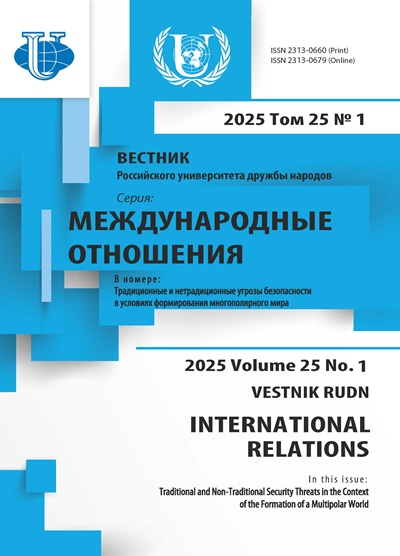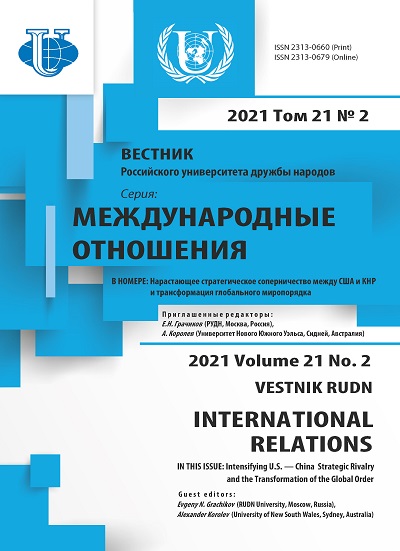Ecological Dimension in China’s Foreign Policy Strategy
- Authors: Boyarkina A.V.1
-
Affiliations:
- Far Eastern Federal University
- Issue: Vol 21, No 2 (2021): Intensifying U.S. — Сhina Strategic Rivalry and the Transformation of the Global Order
- Pages: 325-337
- Section: INTERNATIONAL ECONOMIC RELATIONS
- URL: https://journals.rudn.ru/international-relations/article/view/26780
- DOI: https://doi.org/10.22363/2313-0660-2021-21-2-325-337
Cite item
Full Text
Abstract
Against the backdrop of worsening ecological and climatic threats, which have taken on a truly global scale, states are rethinking their environmental protection approaches to address the growing environmental crisis. The intensive use of natural resources, characteristic of the traditional model of economic growth, no longer corresponds to the “spirit” of the modern environmental agenda. Instead, a new model of eco-culture is being postulated, suggesting a reasonable balance of economic, environmental and social development needs. The relationship between economic development and environmental protection challenges states, including those of the developing world, to switch to clean renewable energy sources, nuclear power plants, and the construction of environmentally friendly housing. As the new “driver” of globalization, China, facing the aggravation of environmental problems, fully understands the timeliness and importance of their solution like no one else. The article analyzes the environmental agenda in China’s modern foreign policy using system analysis and the structural-functional method. The complication of the environmental situation in the PRC forces the country’s leadership to take active measures to combat climate change. Beijing is introducing “eco-culture” into its national development strategy, pursuing a course of building an “ecological civilization” based on respect and protection of nature. The concept of Xi Jinping’s “Community of One Destiny for Mankind” is crucial in the conceptualization of the environmental dimension. An important role is given to the concepts of “ecological civilization” and “two mountains”. With reference to neo-Marxism, the study uses a morphological analysis of the ideology of M. Frieden, according to which the above theories can be classified as nuclear in the general course of socialism with Chinese characteristics. China continues to have a complex and alarming situation with atmospheric pollution. According to the author’s deep conviction, within the framework of the general vector of ensuring the country’s prosperity, the PRC leadership is closely engaged in solving environmental problems, which is understood and supported by the world community. The practical implementation of the environmental agenda is mostly characteristic of Xi Jinping’s foreign policy strategy.
Full Text
Fig. 1. Change in CO2 emissions, 2011—2015
Source: Decrease in China’s coal use sees global emissions fall in 2015 // Carbon Brief Clear on climate. December 7, 2015. URL: https://www.carbonbrief.org/decrease-in-chinas-coal-use-sees-global-emissions-fall-in-2015 (accessed: 26.09.2020).
Table 1. TOP-10 Countries that Emitted the Most Carbon Dioxide into Atmosphere, 2015—2020, millions of tons
№ | Countries | 2015—2016 | 2017 | 2018 | 2019—2020 |
1 | China | 10,671 | 9,839 | 9,528 | 11,535 |
2 | USA | 5,248 | 5,269 | 5,41 | 5,107 |
3 | India | 2,929 | 2,467 | 2,65 | 2,597 |
4 | Russia | 1,730 | 4,7 | 1,587 | 1,792 |
5 | Japan | 1,227 | 3,3 | 1,080 | 1,153 |
6 | Germany | 0,787 | 2,2 | 0,696 | 0,702 |
7 | Iran | 0,630 | 1,9 | 0,579 | 0,701 |
8 | Saudi Arabia | 0,604 | 1,8 | 0,492 | 0,614 |
9 | South Korea | 0,639 | 1,7 | 0, 606 | 0,651 |
10 | Canada | 0,588 | 1,6 | 0,565 | 0,584 |
Source: compiled by the author on the basis of: Emissions CO2 China // World bank. 2016. URL: https://data.worldbank.org/indicator/EN.ATM.CO2E.PC?locations=CN; CO2 Emissions from fuel combustion // International Energy Agency. 2018. URL: http://energyatlas.iea.org/#!/tellmap/1378539487; Chart of the day: These countries create most of the world’s CO2 emissions // World Economic Forum. June 7, 2019. URL: https://www.weforum.org/agenda/2019/06/chart-of-the-day-these-countries-create-most-of-the-world-s-co2-emissions/; Emissions Database for Global Atmospheric Research // European Commission. URL: https://edgar.jrc.ec.europa.eu; Global Energy Review: CO2 Emissions in 2020 // IEA. March, 2021. URL: https://www.iea.org/articles/global-energy-review-co2-emissions-in-2020 (accessed: 21.02.2021).
About the authors
Anna Vladimirovna Boyarkina
Far Eastern Federal University
Author for correspondence.
Email: boyarkina.av@dvfu.ru
ORCID iD: 0000-0001-9819-8171
PhD in Politics, Associate Professor, Oriental Institute - School of Regional and International Studies
Vladivostok, Russian FederationReferences
- Chen Zhenyi. (2016). Makesi zhuyi shengtai wenming guan yu zhongguo chuantong shngtai sixiang ronghe de lujing xuanze [Combining the Marxist View of Ecological Civilization and Chinese Traditional Ecological Thought]. Cai Zhi, (6), 278. (In Chinese).
- Dickens, P. (1992). Society and nature. Towards a green social theory. New York, London: Harvester-Wheatsheaf.
- Douglas, M., & Wildavsky, A. (1982). Risk and culture: An essay on the selection of technical and environmental dangers. Berkeley: University of California Press.
- Kranina, E.I. (2016). Speeding-up the creation of “ecologically friendly civilization” in China. Far Eastern Affairs, (5), 102—111. (In Russian).
- Kranina, E.I. (2017). Acceleration of advance of construction of an “ecological civilization” China. In A.V. Ostrovskiy (Eds.), Results of the 12th five-year plan (2011—2015) and prospects for the development of China’s economy until 2020 (рр. 317—330). Moscow: IDV RAN publ. (In Russian).
- Kranina, E.I. (2020). The strategy of “green” development in China. Far Eastern Affairs, (2), 138—151. (In Russian). https://doi.org/10.31857/S013128120009857-3
- Landrigan, Ph., Fuller, R., Acosta, N., Adeyi, O., Arnold R., Basu, N. et al. (2018). The Lancet Commission on pollution and health. The Lancet, 391(10119), 462—512. https://doi.org/10.1016/S0140-6736(17)32345-0
- Lees, E., & Shepherd, E. (2018). Morphological analysis of legal ideology: locating interpretive divergence. Journal of Property, Planning and Environmental Law, 10(1), 5—16. https://doi.org/10.1108/JPPEL-12-2017-0041
- Lipets, E.Yu. (2017). Cultural ecology: modern aspects of the study of ethnic culture. Scientific Thought of Caucasus, (4), 42—46. (In Russian).
- Milbrath, L.W. (1984). Environmentalists, vanguard for a new society. New York: State University of New York Press.
- Mozias, P.M. (2016). Ecological policy in China: Up the stairs leading down? Obshchestvo i Gosudarstvo v Kitae, (2), 274—314. (In Russian).
- Shmeleva, I.A., & Wan, G.J. (2009). The ecological dimension of politics of modern China. Political Expertise: Polytex, 5(4), 191—209. (In Russian).
- Tobin, L. (2018). Xi’s vision for transforming global governance a strategic challenge for Washington and its allies. Texas National Security Power, 2(1), 155—166. http://dx.doi.org/10.26153/tsw/863
- Tomberg, I.R. (2017). Formation of China’s energy policy at the beginning of the 21st century: internal resources and world economic prospects [thesis’ abstract]. Moscow: IV RAN publ. (In Russian).
- Ushakov, I.V. (2019). Ecological civilization: Dream or mirage? Far Eastern Affairs, (S5-1), 112—122. (In Russian). http://dx.doi.org/10.31857/S013128120007132-6
- Vakleva, Z. (2017). About the category of ecological culture. Научни трудове на съюза на учените — пловдив. Серия А: Обществени науки, Изкуство и Култура, (4), 257—261.
- Vernadsky, V.I. (1940). Biogeochemical essays. 1922—1932. Moscow — Leningrad: Akademiya nauk SSSR publ. (In Russian).
- Vernadsky, V.I. (2001). Letters: 1926—1934. Moscow: Nauka publ. (In Russian).
- Xiao Qing, H. (2018). Xijinping xin shidai zhongguo tese shehui zhuyi shengtai wenming guan. Shehui kexue qianyan [Xi Jinping’s perspective on a socialist ecological civilization with Chinese characteristics in a new era. Social Sciences Frontiers], 7(9), 1531—1535. (In Chinese).
- Ying, W. (2019). Zhongguo chuantong shengtai guan de lishi jianjie [Historical warning in the context of China’s traditional ecological concepts]. Renmin Luntan, (24), 162—163. (In Chinese).
- Zhao, X. (2018). In pursuit of a community of shared future. World Century Publishing Corporation and Shanghai Institutes for International Studies China Quarterly of International Strategic Studies, 4(1), 23—37.
- Zharikov, E.P. (2017). Ecology in the RFE regions bordering with China. Aziatsko-Tikhookeanskii Region: Ekonomika, Politika, Pravo, (1), 21—32. (In Russian). https://doi.org/10.24866/1813-3274/2017-1/21-32
Supplementary files












